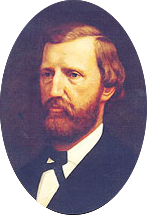Peter Hansborough Bell
Peter Hansborough Bell | |
|---|---|
 | |
| 3rd Governor of Texas | |
| In office December 21, 1849 – November 23, 1853 | |
| Lieutenant | John Alexander Greer James W. Henderson |
| Preceded by | George T. Wood |
| Succeeded by | James W. Henderson |
| Member of the U.S. House of Representatives from Texas's 2nd district | |
| In office March 4, 1853 – March 3, 1857 | |
| Preceded by | Volney E. Howard |
| Succeeded by | Andrew J. Hamilton |
| Personal details | |
| Born | May 11, 1810 Culpeper County, Virginia |
| Died | March 8, 1898 (aged 87) Littleton, North Carolina |
| Political party | Democratic |
| Spouse | Ella Rives Eaton |
| Profession | Politician |
Peter Hansborough Bell (May 11, 1810[Note 1] – March 8, 1898) was an American military officer and politician who served as the third Governor of Texas and represented the state for two terms in the United States House of Representatives.
Background
Bell was born March 11, 1810 in Culpeper County, Virginia.[1][Note 1] He was educated in Virginia and Maryland before emigrating to Texas.[2]
By March 1836, Bell was a member of the Texian Army under Sam Houston and was present at the Battle of San Jacinto. His military service was distinguished and General Houston appointed him to the general's staff as adjutant general.[3] By 1839 Bell had been promoted to Inspector General for the Republic of Texas' army.[2]
In 1845 Bell was named a captain of the Texas Rangers.[2] Given command of the Corpus Christi district, he protected the primary trade route between Texas and Mexico from outlaws.[3] With the outbreak of the Mexican-American war, Bell became a lieutenant colonel in the Second Regiment Texas Mounted Volunteers.[1] His actions during the Battle of Buena Vista were particularly distinguished.[2] Following the war he returned to the Rangers and served along the western frontier.[4]
Governorship
During the 1849 Texas gubernatorial election, Bell ran on a platform advocating strong frontier defense and support of Texas's territorial claim to New Mexico. To this end he called for additional resources to eradicate the Native Americans population and sending troops to Santa Fe in support of Texas' claim to Santa Fe County. This platform allowed him to defeat incumbent Governor George T. Wood by a vote of 10,319 to 8,754.[5]
Shortly after Bell's December 1849 inauguration, the Texas Legislature created three new counties from the southern section of Santa Fe County. The governor sent Robert Neighbors to oversee the organization of the new counties. Neighbors found the inhabitants of the new counties hostile to Texas interests and that residents of Santa Fe had written their own constitution.
After Neighbors' report became public in June 1850, Governor Bell called a special session of the state legislature to deal with these developments. The issue was resolved several months later in the Compromise of 1850, Bell signing Texas' acceptance legislation on November 25, 1850.[6]
Bell won reelection in 1851 due to his aggressive policies and his being the most Southern of the five candidates. Highlights of his second term were payment of Texas' public debt and resolution of land claim disputes between empresarios and their colonists. The governor left office before the end of his term to take a seat in the United States Congress.[7]
Later life
Beginning in 1853, Bell represented Texas' western district in the U.S. House of Representatives for two terms.[1] During this time he became friends with United States Secretary of War Jefferson Davis. He also met and married Ella Rives Eaton of North Carolina. After his marriage, Bell never returned to Texas during his lifetime.[7]
Following his 1857 marriage, Bell and his wife settled in Littleton, North Carolina. When the American Civil War began, he raised and paid to equip a regiment with his personal funds. He then served as the regiment's colonel.[1]
The war left Bell financially ruined and living in poverty. After the Texas Legislature learned this, they awarded the former governor an annual pension of US$150 and 1,280 acres (5.2 km2).[7] Bell died in Littleton, North Carolina on March 11, 1898.[8] His body was reburied with honors in Austin, Texas in 1929.[7]
Bell County, Texas is named for him.
Footnotes
References
- ^ a b c d Coyner, C. Luther (July 1899). "Peter Hansborough Bell". The Quarterly of the Texas State Historical Association. 3 (1). Texas State Historical Association: 49–53. JSTOR 30242699.
- ^ a b c d James T. White & Company (1899). The National Cyclopædia of American Biography. Vol. Volume IX. New York: James T. White & Co. OCLC 1759175.
{{cite book}}:|volume=has extra text (help) - ^ a b Hendrickson, Kenneth E., Jr. (1995). Chief executives of Texas : from Stephen F. Austin to John B. Connally, Jr. College Station: Texas A&M University Press. p. 54. ISBN 0-89096-641-9.
{{cite book}}: CS1 maint: multiple names: authors list (link) - ^ Hendrickson p. 54-6
- ^ Hendrickson p. 53
- ^ Hendrickson p. 56
- ^ a b c d Hendrickson p. 57
- ^ "Death List of a Day". New York Times. March 12, 1898. p. 7.
External links
- Peter Hansborough Bell from the Handbook of Texas Online
- United States Congress. "Peter Hansborough Bell (id: B000344)". Biographical Directory of the United States Congress.
- Peter Hansborough Bell at Find a Grave
- 1810 births
- 1898 deaths
- Governors of Texas
- Members of the United States House of Representatives from Texas
- American military personnel of the Mexican–American War
- People from Culpeper County, Virginia
- Members of the Texas Ranger Division
- People from Littleton, North Carolina
- Texas Democrats
- Democratic Party members of the United States House of Representatives
- Democratic Party state governors of the United States
- 19th-century American politicians


